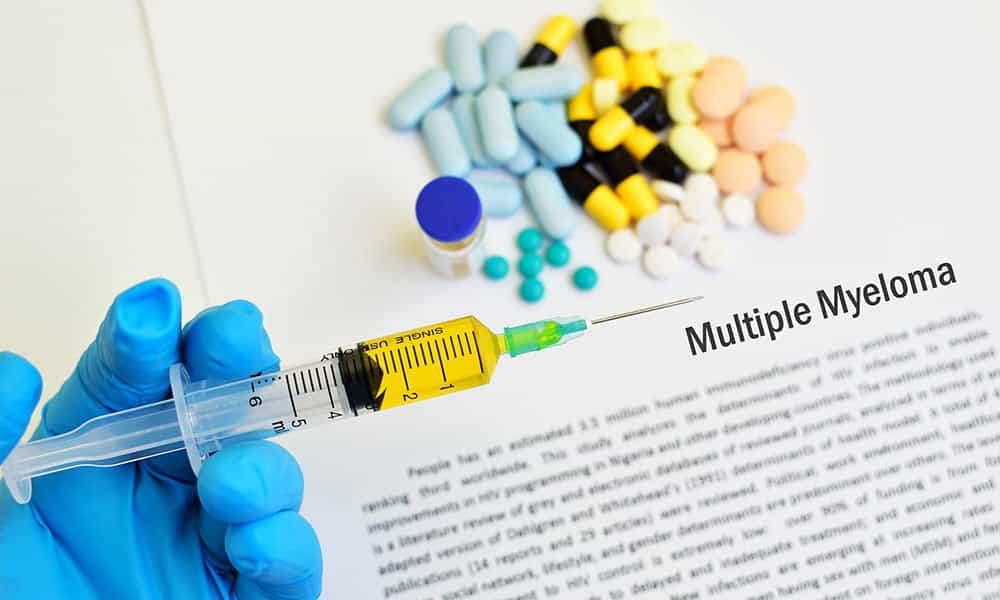When multiple myeloma is diagnosed, it is the doctor who decides with the patient what treatment is best for the specific case. The decision is not easy, and treatment may be different for each individual.
It is not always necessary to start treatment when multiple myeloma is diagnosed. The decision about whether to start treatment immediately depends on the results of your bone marrow examination, imaging tests and blood tests, as well as whether at least one of the so-called CRAB criteria is met.
The CRAB criteria are generally met if multiple myeloma is already causing symptoms. If this is the case, the doctor will begin treatment immediately.
High-dose chemotherapy and autologous stem cell transplantation
A long period of remission from multiple myeloma can be achieved by using high-dose chemotherapy, followed by an autologous stem cell transplant. The goal of such therapy is to destroy as many myeloma cells as possible. Because chemotherapy also affects healthy bone marrow cells, the patient will subsequently receive an infusion of healthy cells that will have been taken from his or her own blood on a previous occasion. This process is called autologous stem cell transplantation.
However, this type of treatment is best suited for younger, fitter patients up to the age of about 65-70, because they often tolerate side effects better than older patients. For this reason, high-dose chemotherapy followed by stem cell transplantation is often not an option in older or less fit patients.
When high-dose chemotherapy followed by stem cell transplantation is not possible, other medications are currently available.
Alternative therapeutic measures
In recent years, tremendous progress has been made in the treatment of multiple myeloma.
As a result of intensive research, more than twice the number of drugs are now available than 10 years ago, and more are in development. This has significantly improved the outlook and quality of life for those affected.
The drugs mainly used are corticosteroids, immunomodulators (lenalidomide, thalidomide, pomalidomide), proteasome inhibitors (bortezomib and analogs), monoclonal antibodies (daratumumab and elotuzumab).
Supportive therapies for multiple myeloma
Moreover, support therapies are fundamental in the treatment of multiple myeloma, useful, regardless of the treatment of the disease, to improve the quality of life, often severely compromised since the diagnosis.
Hypercalcemia
If the side effect is mild, the doctor may recommend to increase hydration or prescribe steroids.
Kidney failure
the doctor will avoid giving drugs that are toxic to the kidney, treat hypercalcemia, and in some cases may indicate dialysis to help the kidneys function better
Bone pain
in case of pain the doctor may prescribe the use of drugs that can relieve this symptom, there are many types and very effective
Peripheral neuropathy
Some drugs used to treat myeloma may cause symptoms such as altered sensitivity, pain, weakness, numbness in the hands and feet, the doctor has now many drugs available to alleviate these problems
Hyperuricemia
sometimes uric acid increases, in these cases specific drugs are administered to reduce its formation in the body and therefore the concentration in the blood, avoiding the onset of further problems such as kidneys
Bone disease
To treat bone disease, your doctor may prescribe bisphosphonates, such as zoledronic acid. Bisphosphonates counteract the loss of bone density.
Anemia
To increase the number of red blood cells, your doctor may prescribe the hormone darbepoetin alfa or recombinant erythropoietin (EPO). Both are artificially produced human erythropoietins that stimulate red blood cell production.
Severe granulocytopenia
If the concentration of white blood cells, called neutrophil granulocytes, becomes excessively low, the patient may be treated with a stimulating factor, granulocyte colony-stimulating factor (G-CSF). A low concentration of neutrophil granulocytes weakens the immune system. G-CSF stimulates the regeneration of neutrophil granulocytes.
Infections
Multiple myeloma and related treatments may increase your chances of getting an infection. Therefore, at the first sign of infection, your doctor may prescribe antibiotics.
Motor rehabilitation and psychological support are also important.
You may also like
Symptoms of multiple sclerosis in women
Multiple sclerosis (MS) is an autoimmune disease that affects the central nervous system, causing a variety of symptoms in women of all ages. MS is a chronic disease that progressively evolves and can have negative consequences on the quality of life of affected women. One of the main symptoms of MS in women is fatigue.… Continue reading Symptoms of multiple sclerosis in women
Symptoms of multiple sclerosis in men
Multiple sclerosis (MS) is a chronic disease of the central nervous system that affects millions of people worldwide, including a significant number of men. MS is an autoimmune disease that affects myelin, a substance that surrounds and protects nerve cells in the brain and spinal cord. This impairs the brain’s ability to communicate with the… Continue reading Symptoms of multiple sclerosis in men
What is atopic dermatitis and which treatments are most suitable
Atopic dermatitis, also known as endogenous eczema, is a benign disease with a multifactorial aetiology, which, together with asthma and allergic rhinitis, is one of the atopic diseases, i.e. diseases related to the tendency of certain (atopic) individuals to manifest amplified immune responses to small amounts of allergens. We distinguish two forms of atopic dermatitis… Continue reading What is atopic dermatitis and which treatments are most suitable
Atopic dermatitis: what it is and its symptoms
The aetiopathogenesis of atopic dermatitis The exact aetiopathogenesis of atopic dermatitis is not known, but certainly involves genetic and environmental factors. Atopic dermatitis is often associated with elevated serum levels of total IgE, the immunoglobulins that are formed following an allergic and immunological reaction, and the presence of specific IgE directed towards aeroallergens or food… Continue reading Atopic dermatitis: what it is and its symptoms
